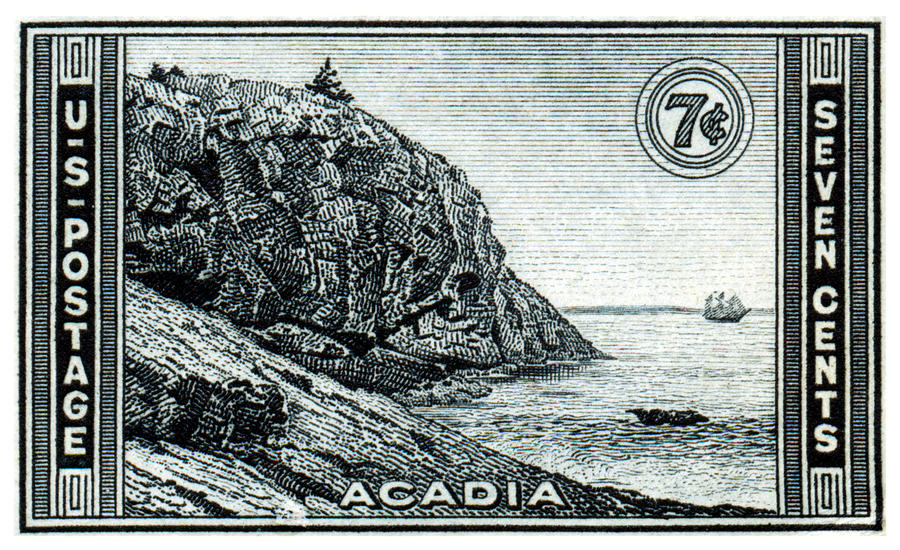A little history:
Behind the inspiration of Park Guides Iconic Vintage Postage Stamp Print, we'll explore the brilliant minds behind the stamp designs, the intricate process of stamp printing, unveil the national parks featured on each stamp along with their release dates, and delve into the selection process. Finally, we'll uncover the present-day value of these remarkable stamps in US dollars. Get ready to be immersed in the wonders of Yosemite, Grand Canyon, Mount Rainier, Mesa Verde, Yellowstone, Crater Lake, Acadia, Zion, Glacier, and Great Smoky Mountains.
The Artistic Visionaries:
The National Park Stamps of the 1930s owe their captivating designs to a talented array of artists. Among them were Thomas Moran, Rudolph Wendelin, Edwin H. Mitchell, and more, who skillfully captured the essence of America's breathtaking national parks. Their artistry brought these stamps to life, immersing collectors in the splendor of nature with each vivid stroke.
The Intricate Process of Stamp Printing:
Stamp printing in the 1930s required a harmonious blend of technical expertise and artistic finesse. Engraved plates were meticulously created to capture the minute details of each design. These plates were then utilized in the printing presses, expertly layering vibrant inks onto the stamp paper. The result was a testament to craftsmanship, showcasing the awe-inspiring landscapes of America's national parks in stunning detail.
The Parks and Their Release Dates:
Let's embark on a journey through the national parks featured on the stamps, along with their release dates:
- One Cent Yosemite National Park (July 16, 1934 ): This stamp showcased the iconic Yosemite Valley, with its towering granite cliffs, majestic waterfalls, and verdant forests.

- Two Cent Grand Canyon National Park (July 24, 1934): The stamp immortalized the awe-inspiring grandeur of the Grand Canyon, with its deep canyons, colorful rock formations, and the mighty Colorado River.

- Three Cent Mount Rainier National Park (August 3, 1934): This stamp captured the snow-capped peak of Mount Rainier, surrounded by the park's lush meadows, crystal-clear lakes, and ancient forests.

- Four Cent Mesa Verde National Park (September 25, 1934): The stamp highlighted the cliff dwellings of Mesa Verde, providing a glimpse into the ancient Native American civilizations that once thrived within the park.

- Five Cent Yellowstone National Park (July 30, 1934): The stamp celebrated the world's first national park, featuring the iconic Old Faithful geyser, colorful hot springs, and the diverse wildlife that roam its vast wilderness.

- Six Cent Crater Lake National Park (September 5, 1934): This stamp showcased the mesmerizing sapphire-blue waters of Crater Lake, formed within the caldera of an ancient volcano and surrounded by towering cliffs

- Seven Cent Acadia National Park (October 2, 1934): The stamp depicted the rugged coastal beauty of Acadia, with its granite peaks, picturesque islands, and the crashing waves of the Atlantic Ocean.

- Eight Cent Zion National Park (September 18, 1934: This stamp captured the majestic red cliffs, deep canyons, and winding rivers that define the unique landscape of Zion.

- Nine Cent Glacier National Park (August 27, 1934): The stamp showcased the rugged peaks, pristine lakes, and icy glaciers that adorn this breathtaking park in the heart of the Rocky Mountains.

- Great Smoky Mountains National Park (October 8, 1934): The stamp immortalized the mist-covered peaks, lush forests, and vibrant wildflowers that make the Great Smoky Mountains a natural wonder.

Selecting the Parks: A Tapestry of Natural Splendor:
The process of selecting the national parks to feature on these stamps aimed to showcase the remarkable diversity of America's natural landscapes. A committee of park enthusiasts, artists, and postal officials meticulously chose the parks based on their iconic beauty, ecological significance, and geographical representation. The goal was to provide a tapestry of national treasures, capturing the essence of America's remarkable natural heritage.
Present-Day Value in US Dollars:
The value of National Park Stamps from the 1930s varies depending on factors such as rarity, condition, and demand among collectors. Individual stamps in good condition can range from $10 to $50, while complete sets or pristine stamps can command higher prices. Collectors and philatelists alike recognize the historical significance, artistic beauty, and cultural value of these stamps, making them highly sought-after collectibles.
The National Park Stamps of the 1930s stand as enduring testaments to the majesty and grandeur of America's national parks. Designed by visionary artists and crafted through intricate printing processes, these stamps continue to captivate collectors and nature enthusiasts alike. From Yosemite's soaring cliffs to the Great Smoky Mountains' mist-laden peaks, each stamp encapsulates the breathtaking beauty of these national treasures. Their present-day value in US dollars reflects their cultural and historical significance, reminding us of the profound natural heritage that awaits exploration within America's national park
